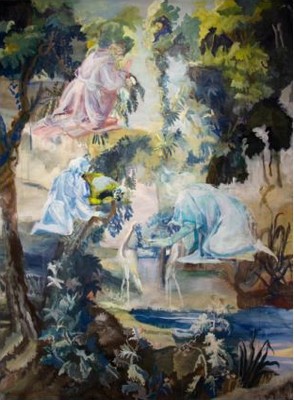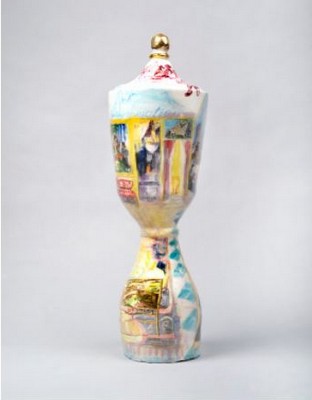Jane Irish
Locks Gallery, Philadelphia
February 23 - March 27, 2021
Supplicant, 2020
Distemper and oil on collaged linen and muslin
78 x 56 inches
© Jane Irish, courtesy Locks Gallery, Philadelphia
Finial Gold Star Mothers, 2020
Low fire whiteware, china paint, lustre, and underglaze
7 x 7 x 20 inches
© Jane Irish, courtesy Locks Gallery, Philadelphia
Locks Gallery presents an exhibition of recent paintings and ceramics by Philadelphia-based artist JANE IRISH (b. 1955).
A prolific and self-described ‘history painter,’ Jane Irish creates confrontations and coexistences in her art between realms of history that rarely collide. In an artist statement she writes, “I think of myself as a sort of international regionalist, finding the history of Philadelphia, and then letting that history lead me around the world.” This approach was perhaps most embodied in Jane Irish’s epic 2018 installation at the historic Lemon Hill Mansion in Philadelphia (organized by Philadelphia Contemporary). For the project, she created a series of paintings based on the idea of ‘antipodes’—defined as hemispheric opposites referencing two points on the globe—and transformed two floors of the mansion into an immersive painted exploration of transhistorical space. Visual references in these paintings include the triangle trade of Henry Pratt, the 18th-century owner of the house; Poe’s writings in Philadelphia (Conchologist’s First Book, Barnaby Rudge, Pym narrative, etc.); 16th-century trade routes of Egypt and Vietnam; and paintings of the 1836 “Wilkes Expedition,” among others. The second floor of the space included imagery from the first national protest of Vietnam Veterans Against the War on Labor Day Weekend 1970, which began in Morristown, NJ, and ended at Valley Forge Park, steps from the Lemon Hill Mansion. Paintings from this series are on view along with a selection of new works from 2019 and 2020.
Central to the exhibition is a series of new ‘tapestry paintings’ made of oil and distemper on hand-stitched linen and muslin. In these works, Jane Irish uses two paint mediums and two types of fabric to create a hybrid picture plane that reflects her desire to construct and interweave multiple histories within a single painting. In the foreground, iconographical figures drawn from old masters paintings appear to float in milky ether across the surface of a traditional-looking pastoral setting. The narratives reference mythical and violent imagery from art history as well as moments of witnessing, prayer and mourning. Additionally, each tapestry corresponds to testimony from the Winter Soldier Investigations of 1971, organized by Vietnam Veterans Against the War (VVAW)—the archives of which Irish has collected and re-typed word for word in a performative act priming her painting process. An accompanying catalog with an essay by poet and art critic Raphael Rubinstein explores Jane Irish’s use of source material in her imagery.
Though not always clearly visible, the lineage of anti-war protest that began with VVAW is a central theme and subtext of much of Jane Irish’s work, which explores ways an artist can embody resistance through the act of image-making. Janes Irish says, “The overall intent of my work is to develop a visual myth and a visual truth about the build-up and aftermath of the Vietnam War and movements of resistance to it.” She calls this a form of “commemorating heroic resistance” and it reflects her longstanding engagement with Vietnam War protest movements, which were seminal to her youth in the 1970s.
Additional works on view include new paintings based on sketches Jane Irish made on-site at the Prado and El Pardo royal hunting lodge in Madrid. In 2019 Jane Irish traveled to Spain, where she made numerous drawings in the former residences of Spanish kings and Francisco Franco, where Goya tapestries are hung in the interiors. A continuation of her ongoing practice of visiting and recording the domiciles of old world rulers, these paintings are not straight realistic depictions of the opulent interiors but fervent and energetic renderings of the artist’s experience of the space. “Painting an interior, seemingly from life, or beginning from life, is only a cue. To me what follows is an act of truth. . . I paint in a view of it which tells the viewer the record is made by an emotive human being—corporeal artist, motif, and viewer in a single project of transforming or re-aligning the political act of seeing.”
Lastly, the exhibition features new ceramic ‘finial’ sculptures for which Jane Irish appropriates the 19th-century architectural form as a means of depicting interiors in the round on the exterior of the objects. Additional ceramics include vessels shaped like ships which are based on historical potpourri holders produced by Sèvres in the late 1750s and early 1760s. These vessels are loaded with narratives and motifs from the period and beyond. As in her paintings, she says, “My work constitutes a reflection on paradoxes of decoration and political order. . . One can be oblivious to what is contained in the wallpaper or on a vase, but one does so in unrealistic detachment from the world. It is all right there is front of us, but not easy to see.”
The gallery is open by appointment only.
LOCKS GALLERY
600 Washington Square South, Philadelphia, PA 19106


